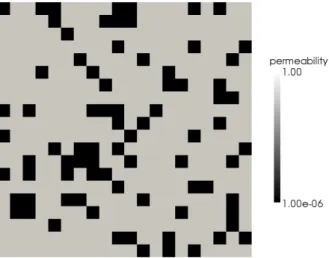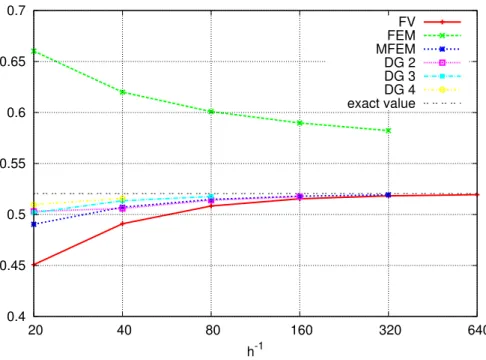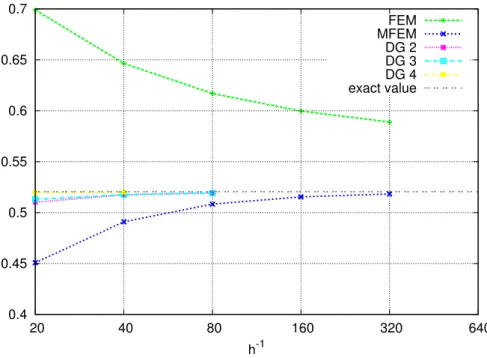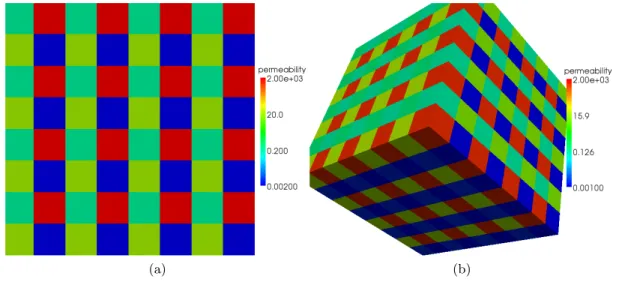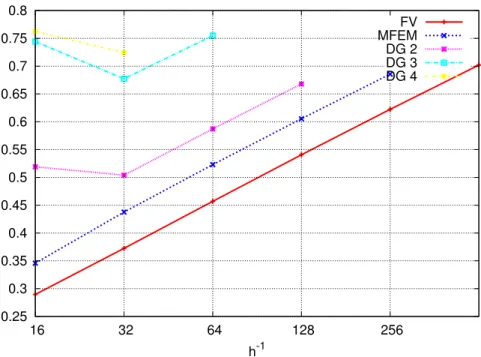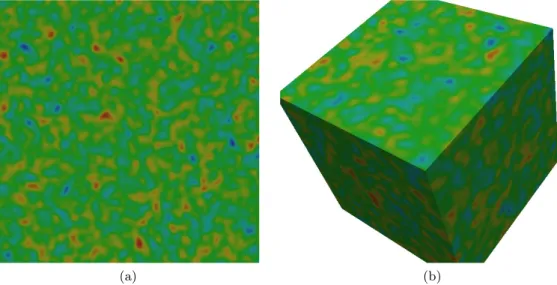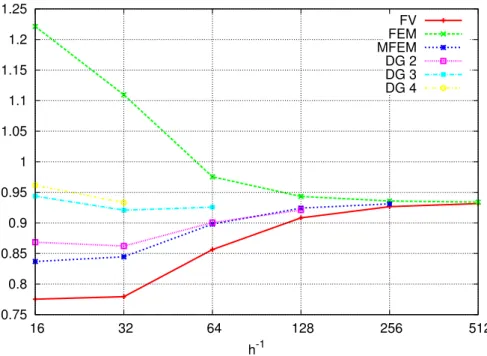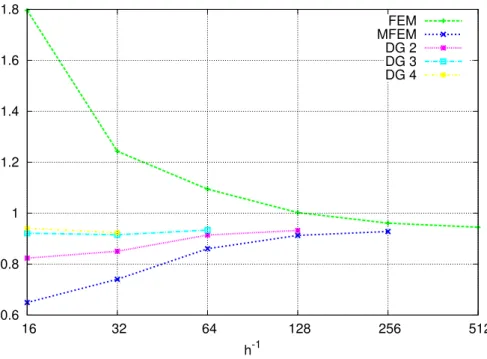Softwarepraktikum
(Wissenschaftliches Rechnen) f¨ ur Fortgeschrittene
Pavel Hron, Arsalan Farooq Ruprecht-Karls-Universit¨at Heidelberg
Interdisziplin¨ares Zentrum f¨ur Wissenschaftliches Rechnen email: paja.hron@email.cz
February 12, 2010
1 Problem Formulation
Consider the steady-state groundwater flow equation (General Diffusion Equation) with corre- sponding Dirichlet and Neumann boundary conditions
−∇ · {K(x)∇p}=f in Ω⊆Rn, n= 2,3, (1a)
p=g on ΓD ⊆∂Ω, (1b)
−(∇ ·K(x)∇p)·n(x) =j on ΓN =∂Ω\ΓD 6=∂Ω, (1c) whereK is the absolute permeability.
K :Rn−→Rn×n is a projection, which relates to each pointx ∈Ω an×n matrixK(x). We demand also (for all x∈ Ω) thatK(x)
1. K(x) =KT(x) andξTK(x)ξ >0 ∀ξ∈Rn, ξ6= 0 (symmetric positive definite), 2. C(x) := min{ξTK(x)ξ| kξk= 1} ≥C0>0 (uniform ellipticity).
In this problem we assume that permeabilityK is strongly varying in the domain Ω.
Denote the volumetric flux function through a porous mediumJ~
J~(x) =−K(x)∇p. (2)
We want to solve the equation (1) in Ω = [0,1]d, without sink or source therms (f = 0) and appropriate boundary conditions. On the left hand side and right hand side of the domain Ω is Dirichlet boundary condition with p = 1 andp = 0 respectively. The upper and the lower boundaries of Ω are impermeable, which means Neumann boundary condition is zero.
Above mentioned problem description we can write in the mathematical form
∇ ·J~(x) = 0 in Ω = [0,1]d, d= 2,3, (3a)
p= 1 on ΓD1 ={x= (x1, . . . , xd)|x1 = 0, x2, . . . , xd∈[0,1]} ⊆∂Ω, (3b) p= 0 on ΓD2 ={x= (x1, . . . , xd)|x1 = 1, x2, . . . , xd∈[0,1]} ⊆∂Ω, (3c)
−∇p·n(x) = 0 on ΓN =∂Ω\(ΓD1∪ΓD2)6=∂Ω. (3d)
The main goal of this project is to get the overall fluxF over the right face ΓD2 of the domain Ω F =
Z
ΓD
2
J~(x)·n(x)dl. (4)
At first we have to solve system (3). For this purpose we use following numerical methods:
• Cell Centered Finite Volumes (FV)
• Mixed Finite Elements (MFEM)
• Conforming Finite Elements (FEM)
• Odeon-Baumann-Babuska Discontinuous Galerkin (DG)
2 Flux implementation in DUNE
The DUNE (Distributed and Unified Numerics Environment, www.dune-project.org) consists of many modules. In the module dune-pdelab-howto above mentioned methods for problem (3) are already implemented. The objective of our work was the implementation of a function, which calculates the integral (4).
2.1 Cell Centered Finite Volumes
The result of (3) for CCFV method is function, which is constant on each grid cell. If we have conforming, structured rectangular (2D) or cuboid (3D) grid, the term ∇p·n(x) on the face can be approximated as
∇p·n(x) = pl−pr
d , (5)
where pl,pr are the values of the pressure p in cells and dis the distance between centroids of this two cells. Then we can evaluate integral (4) using mid-point rule.
pl pr
d
File fluxfv.hh
1 template < typename GV , typename DGF , typename KType >
2 void flux ( const GV & gv , const DGF & dgf , const KType & k )
3 {
4 // f i r s t we e x t r a c t t h e di m e n s i on s o f t h e g r i d
5 const int dim = GV :: dimension ;
6 const int dimworld = GV :: d i m e n s i o n w o r l d ;
7 const double epsilon =1 e -10;
8
9 // d i s c r e t e g r i d f u n c t i o n r an g e t y p e
10 typename DGF :: Traits :: RangeType RT ;
11
12 // k i n s i d e t h e e l e m e n t
13 typename KType :: Traits :: RangeType k_inside ;
14
15 // t y p e u s e d f o r c o o r d i n a t e s i n t h e g r i d
16 typedef typename GV :: ctype ct ;
17
18 // e l e m e n t i t e r a t o r s
19 typedef typename GV :: template Codim <0 >:: Iterator E l e m e n t L e a f I t e r a t o r ;
20 typedef typename GV :: I n t e r s e c t i o n I t e r a t o r I n t e r s e c t i o n I t e r a t o r ;
21
22 // f l u x o v e r a l l
23 double flux_sum =0.0;
24 // l o o p ov e r e l e m e n t s
25 for ( E l e m e n t L e a f I t e r a t o r it = gv . template begin <0 >();
26 it != gv . template end <0 >(); ++ it )
27 {
28 // c e l l geometry t y p e
29 Dune :: G e o m e t r y T y p e gt = it - > type ();
30
31 // c e l l c e n t e r i n r e f e r e n c e e l e m e n t
32 const Dune :: FieldVector < ct , dim >& local = Dune :: Referenc eEl e me nt s < ct , dim >::
33 general ( gt ). position (0 ,0);
34
35 // c e l l c e n t e r i n g l o b a l c o o r d i n a t e s
37 global = it - > geometry (). global ( local );
38
39 // c e l l volume , assume l i n e a r map he r e
40 double volume = it - > geometry (). i n t e g r a t i o n E l e m e n t ( loca l )
41 * Dune :: ReferenceEl em en t s < ct , dim >:: general ( gt ). volum e ();
42
43 // run t h r o u g h a l l i n t e r s e c t i o n s w i t h n e i g h b o r s and boundary
44 I n t e r s e c t i o n I t e r a t o r isend = gv . iend (* it );
45 for ( I n t e r s e c t i o n I t e r a t o r is = gv . ibegin (* it ); is != isend ; ++ is )
46 {
47 // g e t geometry t y p e o f f a c e
48 Dune :: G e o m e t r y T y p e gtf = is - > type ();
49
50 // c e n t e r i n f a c e ’ s r e f e r e n c e e l e m e n t
51 const Dune :: FieldVector < ct , dim -1 >&
52 facelocal = Dune :: ReferenceEl em e nt s < ct , dim -1 >:: genera l ( gtf ). position (0 ,0);
53
54 // c e l l c e n t e r i n g l o b a l c o o r d i n a t e s
55 Dune :: FieldVector < ct , dimworld >
56 faceglobal = is - > geometry (). global ( facelocal );
57
58 // f a c e volume
59 ct face_volum e = is - > i n t e r s e c t i o n G l o b a l (). volume ();
60
61 // d i s t a n c e : e l e m e n t c e n t e r t o f a c e c e n t e r
62 float d =0;
63 for ( size_t i =0; i < dim ; i ++)
64 {
65 d +=( faceglobal [ i ] - global [ i ])*( facegloba l [ i ] - global [ i ]);
66 }
67 d = sqrt ( d );
68
69 // f l u x e v a l u a t i o n
70 if ( fabs ( faceglobal [0] -1.0) < epsilon )
71 {
72 dgf . evaluate (*( it ) , local , RT );
73 k . evaluate (*( it ) , local , k_inside );
74 flux_sum += face_volum e * k_inside * RT / d ;
75 }
76 }
77 }
78 std :: cout << " flux overall " << flux_sum << std :: endl ;
79 80 }
2.2 Mixed Finite Elements
If we use MFEM method, we gain not only pressurep, but also the termJ~(x). That is why the calculation of integral (4) is easy.
1 template < typename GV , typename RT0DGF >
2 void flux ( const GV & gv , const RT0DGF & rt0dgf )
3 {
4 double flux_sum =0.0;
5 double epsilon =1 e -10;
6
7 // f i r s t we e x t r a c t t h e di m e n s i on s o f t h e g r i d
8 const int dim = GV :: dimension ;
9 const int dimworld = GV :: d i m e n s i o n w o r l d ;
10
11 typename RT0DGF :: Traits :: RangeType RT ;
12 typedef typename RT0DGF :: Traits :: D o m a i n F i e l d T y p e DF ;
13 typedef typename RT0DGF :: Traits :: R a n g e F i e l d T y p e RF ;
14 15
16 // t y p e u s e d f o r c o o r d i n a t e s i n t h e g r i d
17 typedef typename GV :: ctype ct ;
18 typedef typename GV :: template Codim <0 >:: Iterator E l e m e n t L e a f I t e r a t o r ;
19 typedef typename GV :: I n t e r s e c t i o n I t e r a t o r I n t e r s e c t i o n I t e r a t o r ;
20
21 // l o o p ov e r e l e m e n t s
22 for ( E l e m e n t L e a f I t e r a t o r it = gv . template begin <0 >();
23 it != gv . template end <0 >(); ++ it )
24 {
25 // c e l l geometry t y p e
26 Dune :: G e o m e t r y T y p e gt = it - > type ();
27
28 // c e l l c e n t e r i n r e f e r e n c e e l e m e n t
29 const Dune :: FieldVector < ct , dim >&
30 local = Dune :: ReferenceEle m en ts < ct , dim >:: general ( gt ). position (0 ,0);
31
32 // run t h r o u g h a l l i n t e r s e c t i o n s w i t h n e i g h b o r s and boundary
33 I n t e r s e c t i o n I t e r a t o r isend = gv . iend (* it );
34 for ( I n t e r s e c t i o n I t e r a t o r is = gv . ibegin (* it ); is != isend ; ++ is )
35 {
36 // g e t geometry t y p e o f f a c e
37 Dune :: G e o m e t r y T y p e gtf = is - > type ();
38
39 // c e n t e r i n f a c e ’ s r e f e r e n c e e l e m e n t
40 const Dune :: FieldVector < ct , dim -1 >&
41 facelocal = Dune :: ReferenceEl em e nt s < ct , dim -1 >:: genera l ( gtf ). position (0 ,0);
42
43 // c e n t e r o f f a c e i n g l o b a l c o o r d i n a t e s
44 Dune :: FieldVector < ct , dimworld > faceglobal = is - > geomet ry (). global ( facelocal );
45 46
47 // i s t h e x−c o o r d i n a t e s o f f a c e c e n t e r = 1
48 if ( fabs ( faceglobal [0] -1.0) < epsilon )
49 {
50 // g e t normal v e c t o r s c a l e d w i t h volume
51 Dune :: FieldVector < ct , dimworld > i n t e g r a t i o n O u t e r N o r m a l =
52 is - > i n t e g r a t i o n O u t e r N o r m a l ( facelocal );
53 i n t e g r a t i o n O u t e r N o r m a l *=
54 Dune :: ReferenceEl em en t s < ct , dim -1 >:: general ( gtf ). vol ume ();
55
56 // l o o p ov e r q u a d r a t u r e r u l e s , o r d e r=1
57 const Dune :: QuadratureRule < DF , dim -1 >& rule =
58 Dune :: QuadratureRul es < DF , dim -1 >:: rule ( gtf ,1);
59 for ( typename Dune :: QuadratureRule < DF , dim -1 >:: c o n s t _ i t e r a t o r cit =
60 rule . begin (); cit != rule . end (); ++ cit )
61 {
62 // p o s i t i o n o f q u a d r a t u r e p o i n t i n l o c a l c o o r d i n a t e s o f e l e me n t
63 Dune :: FieldVector < DF , dim > local =
64 is - > g e o m e t r y I n I n s i d e (). global ( cit - > position ());
65 RF factor = cit - > weight ();
66
67 // k∗v e l o c i t y e v a l u a t i o n
68 rt0dgf . evaluate (* it , local , RT );
69
70 flux_sum += i n t e g r a t i o n O u t e r N o r m a l * RT * factor ;
71
72 } // c i t
73
74 } // b o r d e r
75
76 } // i s
77 } // i t
78 std :: cout << " flux overall " << flux_sum << std :: endl ;
79 }
2.3 Conforming Finite Elements, Discontinuous Galerkin
The solution p(x) of problem (3) can be expressed as p(x) =X
ei
nei
X
j=1
cei,j·ψei,j(x). (6)
For each element ei there is a set of base functions ψei,j(x), which are multiplicated with coefficients cei,j. Therefore∇p we get as
∇p(x) =X
ei nei
X
j=1
cei,j· ∇ψei,j(x). (7) For evaluation of integral (4) we can use again numerical integration.
1 template < typename GV , typename X , typename GFS , typename KType >
2 void flux ( const GV & gv , const X & x , const GFS & gfs , const KTyp e & k , int intorder =1)
3 {
4
5 double flux_sum =0.0;
6 double epsilon =1 e -10;
7
8 // f i r s t we e x t r a c t t h e di m e n s i on s o f t h e g r i d
9 const int dim = GV :: dimension ;
10 const int dimw = GV :: d i m e n s i o n w o r l d ;
11
12 typedef typename GFS :: L o c a l F u n c t i o n S p a c e :: Traits :: L o c a l F i n i t e E l e m e n t T y p e ::
13 Traits :: L o c a l B a s i s T y p e :: Traits :: D o m a i n F i e l d T y p e DF ;
14 typedef typename GFS :: L o c a l F u n c t i o n S p a c e :: Traits :: L o c a l F i n i t e E l e m e n t T y p e ::
15 Traits :: L o c a l B a s i s T y p e :: Traits :: R a n g e F i e l d T y p e RF ;
16 typedef typename GFS :: L o c a l F u n c t i o n S p a c e :: Traits :: L o c a l F i n i t e E l e m e n t T y p e ::
17 Traits :: L o c a l B a s i s T y p e :: Traits :: J a c o b i a n T y p e J a c o b i a n T y p e ;
18
19 typedef typename GFS :: L o c a l F u n c t i o n S p a c e LFS ;
20 LFS lfs ( gfs ); // l o c a l f u n c t i o n s p a c e l
21
22 std :: vector < RF > xl ; // l o c a l c o n t a i n e r
23 typename KType :: Traits :: RangeType k_inside ; // K t e n s o r
24 25
26 // t y p e u s e d f o r c o o r d i n a t e s i n t h e g r i d
27 typedef typename GV :: ctype ct ;
28
29 typedef typename GV :: template Codim <0 >:: Iterator E l e m e n t L e a f I t e r a t o r ;
30 typedef typename GV :: I n t e r s e c t i o n I t e r a t o r I n t e r s e c t i o n I t e r a t o r ;
31
32 for ( E l e m e n t L e a f I t e r a t o r it = gv . template begin <0 >();
33 it != gv . template end <0 >(); ++ it )
34 {
35 // c e l l geometry t y p e
36 Dune :: G e o m e t r y T y p e gt = it - > type ();
37
38 // c e l l c e n t e r i n r e f e r e n c e e l e m e n t
39 const Dune :: FieldVector < ct , dim >&
40 local = Dune :: ReferenceEle m en ts < ct , dim >:: general ( gt ). position (0 ,0);
41
42 // e v a l u a t e k t e n s o r
43 k . evaluate (*( it ) , local , k_inside );
44
45 // run t h r o u g h a l l i n t e r s e c t i o n s w i t h n e i g h b o r s and boundary
46 I n t e r s e c t i o n I t e r a t o r isend = gv . iend (* it );
47 for ( I n t e r s e c t i o n I t e r a t o r is = gv . ibegin (* it ); is != isend ; ++ is )
48 {
49 // g e t geometry t y p e o f f a c e
50 Dune :: G e o m e t r y T y p e gtf = is - > type ();
51
52 // c e n t e r i n f a c e ’ s r e f e r e n c e e l e m e n t
53 const Dune :: FieldVector < ct , dim -1 >&
54 facelocal = Dune :: ReferenceEle me n ts < ct , dim -1 >:: genera l ( gtf ). position (0 ,0);
55
56 // g e t normal v e c t o r s c a l e d w i t h volume
57 Dune :: FieldVector < ct , dimw > i n t e g r a t i o n O u t e r N o r m a l
58 = is - > i n t e g r a t i o n O u t e r N o r m a l ( facelocal );
59 i n t e g r a t i o n O u t e r N o r m a l
60 *= Dune :: ReferenceEl em e nt s < ct , dim -1 >:: general ( gtf ). v olume ();
61
62 // c e n t e r o f f a c e i n g l o b a l c o o r d i n a t e s
63 Dune :: FieldVector < ct , dimw > faceglobal = is - > geometry (). global ( facelocal );
64
65 if ( fabs ( faceglobal [0] -1.0) < epsilon )
66 {
67 // l o o p ov e r q u a d r a t u r e p o i n t s
68 const Dune :: QuadratureRule < DF , dim -1 >& rule =
69 Dune :: QuadratureRul es < DF , dim -1 >:: rule ( gtf , intorder );
70 for ( typename Dune :: QuadratureRule < DF , dim -1 >:: c o n s t _ i t e r a t o r
71 cit = rule . begin (); cit != rule . end (); ++ cit )
72 {
73
74 // p o s i t i o n o f q u a d r a t u r e p o i n t i n l o c a l c o o r d i n a t e s o f e l e me n t
75 Dune :: FieldVector < DF , dim > local =
76 is - > g e o m e t r y I n I n s i d e (). global ( cit - > position ());
77
78 RF factor = cit - > weight ();
79
80 lfs . bind (* it );
81 lfs . vread (x , xl ); // w r i t e l o c a l c o n t a i n e r i n t o x l
82
83 // e v a l u a t e j a c o b i a n
84 std :: vector < JacobianType > js ( lfs . size ());
85 lfs . l o c a l F i n i t e E l e m e n t (). localBasis (). e v a l u a t e J a c o b i a n ( local , js );
86
87 // t r a n s f o r m g r a d i e n t t o r e a l e l e m e n t
88 const Dune :: FieldMatrix < DF , dimw , dim > jac =
89 it - > geometry (). j a c o b i a n I n v e r s e T r a n s p o s e d ( local );
90 std :: vector < Dune :: FieldVector < RF , dim > > gradphi ( lfs . s ize ());
91 for ( size_t i =0; i < lfs . size (); i ++)
92 {
93 gradphi [ i ] = 0.0;
94 jac . umv ( js [ i ][0] , gradphi [ i ]);
95 }
96
97 // compute g r a d i e n t o f u
98 Dune :: FieldVector < RF , dim > gradu (0.0);
99 for ( size_t i =0; i < lfs . size (); i ++)
100 gradu . axpy ( xl [ i ] , gradphi [ i ]);
101
102 // compute K ∗ g r a d i e n t o f u
103 Dune :: FieldVector < RF , dim > Kgradu (0.0);
104 k_inside . umv ( gradu , Kgradu );
105 flux_sum += i n t e g r a t i o n O u t e r N o r m a l * Kgradu * factor ;
106
107 } // c i t
108
109 } // b o r d e r
110
111 } // i s
112 } // i t
113
114 std :: cout << " flux overall " << -1* flux_sum << std :: endl ;
115 116 }
3 Numerical results
In this chapter we will discuss some numerical results for different permeability fields. This examples shows, that the cell-centered Finite Volume Method, Discontinuous Galerkin Method and Mixed Finite Elements Method tend to underestimate the overall flux, the Finite Ele- ment Method tend to overestimate the overall flux. Finite Element Method converges only for continuous permeability fields.
3.1 Durlofsky permeability field
Durlofsky has defined the permeabillity field on a regular 20×20 mesh (see Fig. 1). The permeability in dark areas isK = 10−6, in light areas isK= 1.
The unit square is discretized with 20×20 rectangular elements for cube grid or with 20×20×2 triangular elements for simplex grid. Finer grids are obtained through regular refinement.
The exact value ofF for Durlofsky permeability field1 has been given in as 0.5205. In Table 1 and in Fig. 2 we show results for the unknown overall flux through the systemF with rectangle grid discretization. We compare above mentioned numerical schemes. The results clearly show the unsuitability of the Conforming Finite Element Method for this type of problem, because this method has a bad approximation of average permeability.
For rectangular grid we get good results with the lowest order Mixed Finite Element Method.
Discontinuous Galerkin Method gives the best results, this method is locally mass conservative and in comparison with Finite Volume Method uses more degrees of freedom. The result for triangular grid discretization are shown in Fig. 3 and in Table 2. In this case Mixed Finite Element Method is worse than rectangle grid discretization.
Figure 1: Durlofsky permeability field.
1L. J. Durlofsky,Accuracy of mixed and control volume finite element approximations to Darcy velocity and related quantities, Water Resources Reserach30(1994), no. 4, 965-973
h-1
FV FEM MFEM DG 2 DG 3 DG 4 exact value
0.4 0.45 0.5 0.55 0.6 0.65 0.7
20 40 80 160 320 640
Figure 2: The overall fluxF for the Durlovsky problem calculated with diferent discretization schemes and successive grid refinement, rectangle grid discretization.
h−1 FV MFEM DG, r=2 DG, r=3 DG, r=4 FEM,Q1
20 0.450829 0.490408 0.503091 0.501675 0.509603 0.660146 40 0.49096 0.507119 0.505838 0.513495 0.51577 0.619998 80 0.508343 0.514745 0.513997 0.517623 0.600907
160 0.515426 0.517945 0.517588 0.589748
320 0.518264 0.515426 0.582236
640 0.519393
Table 1: The overall fluxF for the Durlovsky problem, rectangles.
h-1
FEM MFEM DG 2 DG 3 DG 4 exact value
0.4 0.45 0.5 0.55 0.6 0.65 0.7
20 40 80 160 320 640
Figure 3: The overall fluxF for the Durlovsky problem calculated with diferent discretization schemes and successive grid refinement, triangle grid discretization.
h−1 MFEM FEM, P1 DG, r=2 DG, r=3 DG, r=4 20 0.450829 0.699048 0.510242 0.512905 0.519586 40 0.49096 0.646453 0.517507 0.517643 0.519838 80 0.508343 0.616949 0.519378 0.519183
160 0.515426 0.59974 320 0.518264 0.588928 640
Table 2: The overall fluxF for the Durlovsky problem, triangles.
3.2 Discontinuous permeability field
Durlofsky permeability field is discontinuous, it consists of only 2 values. The distribution is irregular. In this example we describe discontinuous permeability field with periodic distribu- tion.
This discontinuous permeability field can be for all x= (x1, x2, x3)∈Ω defined by the formula
K(x) =
20.0 ⌊xh1⌋ even,⌊xh2⌋even,⌊xh3⌋ even 0.002 ⌊xh1⌋ odd,⌊xh2⌋ even,⌊xh3⌋ even 0.2 ⌊xh1⌋ even,⌊xh2⌋odd,⌊xh3⌋ even 2000.0 ⌊xh1⌋ odd,⌊xh2⌋ odd,⌊xh3⌋even 1000.0 ⌊xh1⌋ even,⌊xh2⌋even,⌊xh3⌋ odd 0.001 ⌊xh1⌋ odd,⌊xh2⌋ even,⌊xh3⌋ odd 0.1 ⌊xh1⌋ even,⌊xh2⌋odd,⌊xh3⌋ odd 10.0 ⌊xh1⌋ odd,⌊xh2⌋ odd,⌊xh3⌋odd
. (8)
This permeability field in 2D and in 3D is shown in Figure 4.
The mesh size in this problem is taken as 16×16 to prevent the problem from complexity.
Table 3.2 and 3.2 show the results of the flux for different methods with successive refinements.
As in the case of Finite Element Method, we are not getting good results because this method has a bad approximation for permeability field and not locally mass conservative and secondly it is discrete and not smooth enough. Therefore, we are not including the fluxes for FEM in the graph.
(a) (b)
Figure 4: Discontinuous permeability field.
h-1
FV MFEM DG 2 DG 3 DG 4
0.25 0.3 0.35 0.4 0.45 0.5 0.55 0.6 0.65 0.7 0.75 0.8
16 32 64 128 256
Figure 5: The overall flux F for the discontinuous permeability field (8) in 2D at successive refinements, rectangular grid discritization.
h−1 FV MFEM DG, r=2 DG, r=3 DG, r=4 FEM,Q1
16 0.289657 0.345877 0.519077 0.74418 0.762491 11.6776 32 0.372477 0.437726 0.503865 0.677174 0.724126 9.22717 64 0.45705 0.522987 0.58715 0.754825 7.72284
128 0.540632 0.605493 0.667953 6.6705
256 0.622409 0.685629 5.89056
512 0.701939 5.29135
Table 3: The overall fluxF for the discontinuous permeability field (8) in 2D, rectangles.
h-1
MFEM DG 2 DG 3 DG 4
0.2 0.3 0.4 0.5 0.6 0.7 0.8 0.9
16 32 64 128 256 512
Figure 6: The overall flux F for the discontinuous permeability field (8) in 2D at successive refinements, triangular grid discritization.
h−1 MFEM DG, r=2 DG, r=3 DG, r=4 FEM,P1 16 0.289657 0.569913 0.600637 0.6859 14.2598 32 0.372476 0.652479 0.685519 0.766271 10.9272 64 0.457048 0.734066 0.764934 8.86621
128 0.540628 0.812042 7.48263
256 0.622395 6.49433
512 5.82135
Table 4: The overall fluxF for the discontinuous permeability field (8) in 2D, triangles.
h−1 FV MFEM DG, r=2 FEM,Q1
16 0.163812 0.175001 0.296727 251.52 32 0.217076 0.259619 0.296727 94.7228
64 0.279882 48.9817
128 0.34436 27.0621
Table 5: The overall flux F for the discontinuous permeability field (8) in 3D, cuboids.
3.3 Random permeability field
The function K(x) is log-normal distributed with a given mean of 0, a variance of 3 (i.e. the permeabilities alternating between 10−3 and 103) and a correlation length of 1/64 or 1/16 in 2D and 1/32 or 1/8 in 3D. Examples of these random permeability fields are shown in Fig. 7 and 8.
(a) (b)
Figure 7: Log-normal distributed permeability fields in 2D and 3D, correlation length of 1/64 in 2D and 1/32 in 3D.
(a) (b)
Figure 8: Log-normal distributed permeability fields in 2D and 3D, correlation length of 1/16 in 2D and 1/8 in 3D.
Numerical results for random permeability field with smaller correlation length (Fig. 9, 10 and Tab. 6, 7 and 8) shows, that all methods converge. The rate of convergence is smaller than the rate of convergence for random permeability field with greater correlation length (see Fig.
11, 12 and Tab. 9, 10 and 11). The reason is that random permeability field with greater correlation length is smoother. In this case FEM also converges, in contrast to discontinuous
h-1
FV FEM MFEM DG 2 DG 3 DG 4
0.75 0.8 0.85 0.9 0.95 1 1.05 1.1 1.15 1.2 1.25
16 32 64 128 256 512
Figure 9: The overall flux F for the random permeability field 2D problem with correlation length of 1/64 calculated with diferent discretization schemes and successive grid refinement, rectangle grid discretization.
permeability field.
h−1 FV MFEM DG, r=2 DG, r=3 DG, r=4 FEM,Q1
16 0.77534 0.836949 0.868496 0.943831 0.961535 1.22132 32 0.779322 0.84461 0.8621 0.920732 0.93326 1.1095
64 0.85643 0.898071 0.90065 0.9257423 0.975436
128 0.908352 0.924298 0.921081001 0.943341
256 0.926655 0.931132 0.935863
512 0.931683 0.934049
Table 6: The overall flux F for the random permeability 2D field with correlation length of 1/64, rectangles.
h-1
FEM MFEM DG 2 DG 3 DG 4
0.6 0.8 1 1.2 1.4 1.6 1.8
16 32 64 128 256 512
Figure 10: The overall flux F for the random permeability field 2D problem with correlation length of 1/64 calculated with diferent discretization schemes and successive grid refinement, triangle grid discretization.
h−1 MFEM FEM, P1 DG, r=2 DG, r=3 DG, r=4 16 0.649137 1.79596 0.823581 0.921255 0.940517 32 0.740271 1.24269 0.85048 0.9149971 0.923693 64 0.860335 1.09437 0.91421 0.933646
128 0.912719 1.00245 0.932027 256 0.928019 0.960686
512 0.944735
Table 7: The overall flux F for the random permeability 2D field with correlation length of 1/64, triangles.
h−1 FV MFEM DG, r=2 FEM,Q1
8 1.1449 1.29826 1.35603 2.31804
16 1.01599 1.14758 1.83746
32 1.31719 1.66314
64 1.48614 1.591
128 1.54393
Table 8: The overall flux F for the random permeability 3D field with correlation length of 1/32, cuboids.
h-1
FV FEM MFEM DG 2 DG 3 DG 4
0.76 0.78 0.8 0.82 0.84 0.86 0.88
16 32 64 128 256 512
Figure 11: The overall flux F for the random permeability field 2D problem with correlation length of 1/16 calculated with diferent discretization schemes and successive grid refinement, rectangle grid discretization.
h−1 FV MFEM DG, r=2 DG, r=3 DG, r=4 FEM,Q1
16 0.765417 0.803858 0.805419 0.825815 0.82999 0.870887 32 0.827035 0.843016 0.840281 0.849335 0.849788 0.859714 64 0.845258 0.849771 0.848381 0.851502 0.853922
128 0.85026 0.851424 0.851004 0.852462
256 0.851545 0.851836 0.852078
512 0.851872 0.851995
Table 9: The overall flux F for the random permeability 2D field with correlation length of 1/16, rectangles.
h-1
FEM MFEM DG 2 DG 3 DG 4
0.75 0.8 0.85 0.9 0.95 1 1.05 1.1
16 32 64 128 256 512
Figure 12: The overall flux F for the random permeability field 2D problem with correlation length of 1/16 calculated with diferent discretization schemes and successive grid refinement, triangle grid discretization.
h−1 MFEM FEM, P1 DG, r=2 DG, r=3 DG, r=4 16 0.771213 1.05094 0.815247 0.835966 0.834409 32 0.830419 0.881289 0.848087 0.851209 0.849858 64 0.846369 0.848858 0.85135 0.851946
128 0.850556 0.846326 0.851841 256 0.851618 0.848221
512 0.849876
Table 10: The overall flux F for the random permeability 2D field with correlation length of 1/16, triangles.
h−1 FV MFEM DG, r=2 FEM,Q1
8 0.832339 0.879213 0.882525 0.984478
16 0.910224 0.932414 0.958893
32 0.938126 0.951348
64 0.946078 0.949462
128 0.94814 0.948991
Table 11: The overall flux F for the random permeability 3D field with correlation length of 1/8, cuboids.
